人教版英语九年级 全一册Unit10 SectionB2a-2e教案
人教版九年级英语全册Unit10SectionB2a2eReading教学设计
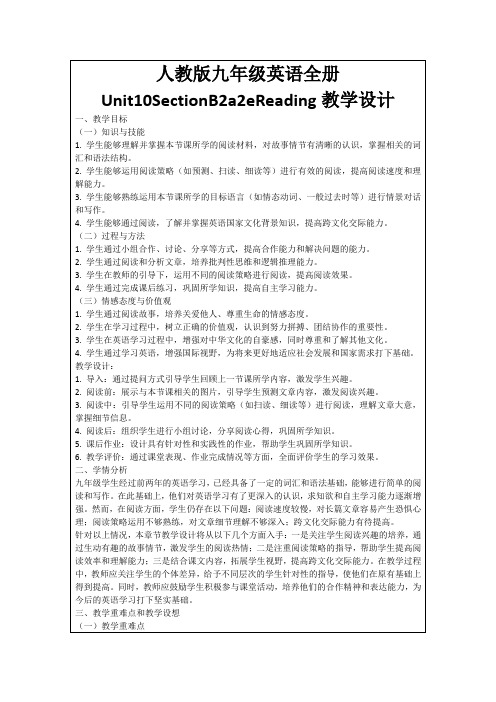
一、教学目标
(一)知识与技能
1.学生能够理解并掌握本节课所学的阅读材料,对故事情节有清晰的认识,掌握相关的词汇和语法结构。
2.学生能够运用阅读策略(如预测、扫读、细读等)进行有效的阅读,提高阅读速度和理解能力。
3.学生能够熟练运用本节课所学的目标语言(如情态动词、一般过去时等)进行情景对话和写作。
4.学生能够通过阅读,了解并掌握英语国家文化背景知识,提高跨文化交际能力。
(二)过程与方法
1.学生通过小组合作、讨论、分享等方式,提高合作能力和解决问题的能力。
2.学生通过阅读和分析文章,培养批判性思维和逻辑推理能力。
3.学生在教师的引导下,运用不同的阅读策略进行阅读,提高阅读效果。
4.学生通过完成课后练习,巩固所学知识,提高自主学习能力。
1.复习本节课所学的词汇和语法,特别是情态动词和一般过去时的用法,并完成课后练习题。
-设计目的:巩固词汇和语法知识,提高学生的实际运用能力。
2.根据本节课所学的阅读材料,编写一段对话,描述老人在海滩上的经历,并尽量运用所学词汇和语法结构。
-设计目的:培养学生的写作能力,激发学生的创造力,同时巩固所学知识。
3.学生分享预测结果,教师给予肯定并引导学生进入新课:“Today, we are going to read a story about a old man who has an interesting experience. Let's find out what happens to him.”
2.各小组讨论结束后,教师邀请小组代表分享讨论成果。
3.教师针对学生的回答给予点评,引导学生深入思考,拓展文章内容。
人教版九年级英语全册教学设计:Unit10sectionB

二、学情分析
九年级的学生已经具备了一定的英语基础,掌握了基本的语法、词汇和阅读技能。在此基础上,他们对英语学习有了更高的期待和追求。然而,学生在学习过程中仍存在以下问题:
1.部分学生对英语学习缺乏兴趣,学习积极性不高,需要激发学习动机。
2.学生的词汇量有限,对一些课文中出现的关键词汇和短语理解困难,影响阅读效果。
3.在语法方面,学生对时态的运用不够熟练,容易混淆,需要加强针对性训练。
4.学生的口语表达能力相对较弱,缺乏自信,需要创造更多实践机会,提高口语水平。
针对以上学情,本章节教学设计将从以下几个方面入手:
1.创设有趣、真实的语境,激发学生的学习兴趣,提高学习积极性。
1.通过小组合作、讨论、分享的方式,激发学生的主动性和积极性,培养合作意识和团队精神。
2.利用问题驱动法,引导学生主动探究文章内容,培养独立思考、解决问题的能力。
3.通过阅读和分析文章,让学生学会运用不同的阅读策略,如预测、扫描、精读等,提高阅读效率。
4.创设真实语境,让学生在情境中进行角色扮演、口头表达等实践活动,提高英语实际运用能力。
2.能够掌握并运用一般过去时、现在完成时等时态描述过去发生的事情以及对现在造成的影响,提高语法运用水平。
3.能够通过阅读理解文章,抓住文章主旨,了解世界各地不同的文化背景,提高阅读理解能力。
4.能够运用所学知识进行口头和书面表达,就过去的事件进行讨论和交流,提升英语表达能力。
(二)过程与方法
在本章节的学习过程中,学生将通过以下方法提升英语能力:
2.练习题难度由浅入深,涵盖词汇、语法、阅读和口语等方面,旨在提高学生的综合运用能力。
人教版九年级英语全册Unit10SectionB(2b)教学设计

(一)教学重难点
1.教学重点:
a.掌握本节课的核心词汇和短语,如achieve, confident, effort, fail, goal, practice, success等。
b.理解并运用一般现在时和现在进行时,能够在实际语境中进行正确的语法运用。
c.能够运用目标句型进行口语交流,如:“How do you achieve your goals?”, “I practice every day.”
(二)过程与方法
在本章节的教学过程中,学生将通过以下方式提升英语能力:
1.通过小组合作、讨论等形式,培养学生的合作意识和团队精神。
2.通过听力训练,提高学生的英语听力水平,培养学生的语音感知能力。
3.通过口语交流,提高学生的英语表达能力,增强学生的自信心。
4.通过阅读训练,提播放与本节课话题相关的对话和短文,提高学生的听力水平。
3.创设写作任务,让学生结合所学词汇和句型,写一篇关于如何实现目标的短文。
(五)总结归纳
1.教师引导学生回顾本节课所学内容,强调重点和难点,确保学生能够掌握。
2.邀请学生分享在本节课中的收获和感悟,鼓励他们树立正确的目标意识,勇于面对挑战。
4.在学习方法上,学生已经具备了一定的自主学习能力,但合作学习和探究学习的能力有待提高。因此,在本节课的教学过程中,教师应注重引导学生开展合作学习,培养学生的团队协作能力。
5.由于每个学生的英语水平、学习兴趣和动机存在差异,教师应关注个体差异,因材施教,激发学生的学习潜能,提高他们的英语素养。总之,教师在本节课的教学中,要充分了解学生的实际情况,有针对性地进行教学设计,以促进学生的全面发展。
四、教学内容与过程
(一)导入新课
人教版九年级英语全册Unit10SectionB(2b)教学设计

4.预习下一课的内容,提前了解关于身体其他部位疾病的表达方式,为课堂学习做好准备。
5.每位同学收集一种疾病的相关资料,包括病因、症状、治疗方法等,下节课与同学分享,增强跨文化交际能力。
作业布置要求:
1.作业内容要与课堂教学紧密结合,注重培养学生的实际运用能力。
2.作业难度要适中,既能巩固所学知识,又能激发学生的学习兴趣。
2.学生在小组内分享自己的观点,共同完成一份关于疾病话题的讨论报告。
3.各小组轮流展示讨论成果,其他小组认真倾听并给予评价。
(四)课堂练习
1.教师设计一系列练习题,包括填空、选择、改错等,让学生巩固所学知识。
2.学生完成练习题,教师给予及时反馈和指导,纠正学生的错误。
3.教师挑选部分学生的练习题进行展示,让其他学生借鉴和学习。
6.教学评价环节:
-采用多元化评价方式,如课堂表现、课后作业、口语表达等,全面评估学生的学习效果。
-注重过程性评价,关注学生在学习过程中的进步和成长。
7.教学策略:
-采用启发式教学,引导学生主动探究,培养学生的学习兴趣和积极性。
-注重个体差异,针对不同学生的学习需求,给予个性化的指导。
-创设轻松、愉快的学习氛围,让学生在愉快的氛围中学习英语。
-设计丰富的练习题,让学生在实际操作中掌握语法知识。
4.口语表达环节:
英语人教版九年级全册unit10 Section B 2A--2B

新目标英语九年级unit10 reading阅读课教学设计隆尧县实验中学王灵彩Unit 10 You`re supposed to shake handsSection B (2a—2e)Ⅰ.Teaching Aims and Demands1.Knowledge Objects(1)Key V ocabularytable manners, behave, be/get used to, cut up, full, fork, You should…(2)Practise reading an article.(3)Practise writing something using the target language.2.Ability Objects(1)Train students’ reading ability.(2)Train students’ writing ability.Ⅱ.Teaching Key PointPractise reading and writing using the target language.Ⅲ.Teaching Difficult Point1. How to improve students’ listening and reading ability.How to write an e-mail message.2. How to help students to express their opinion freely.Ⅳ.Teaching Procedures Step1. Warming up Sing an English song---Jingle Bells and have a free talk with students.T: Can you sing the song? Do you like the song? Do you know when we usually sing the song? We usually sing it on Christmas Day. Now it’s December, the Christmas day is coming. I am very happy, and I guess I will be happier than any other years. Why? Because one of my students sent me an E-mail card for Christmas Day . What’s more, he wrote all in English. (Show the PPT)设计意图:通过Jingle Bells这首歌可营造气氛,并自然引入教学内容Step2. Lead-in (pre-reading) T: But What a pity, I can’t understand his English. Would you like to help me? Look at his card please. Would you please tell me what’s the meaning of it? (show the card on the screen) T: Who can tell me what does the “RU”,”gr8”….means? Ss try their best to guess the meaning, but can’t get meaning of “CSL and BTY”. T: Don’t worry, I have sent Xiao Peng an e-mail to ask for help. Show the answers of these E-mail English, and tell Ss it’s called E-mail English. Then ask Ss to try to read the card for me.设计意图:通过学生寄给我的用E-mail English写的贺卡自然导入,初步了解本课重点E-mail English.Step3 While-reading T: But at the end of Xiao Peng’s card, he said that: “Miss Liu, you are out! The e-mail English is very popular now. ”T: Oh no, I don’t want to be out. I’m fashion, Do you want to be out? T: OK, so I want to know more about the E-mail English, let’s go Task 1 Three questions : 1).Why do we use e-mail English ? 2).Where does it come from? 3).When is it supposed to be used? Please try to read the passage and find out which paragraph can tell us the information.设计意图:通过三个问题的提出,让学生阅读1、2、5 段,使学生对于e-mail English 的定义、优点及使用场合有大致了解。
Unit10SectionB2a~2e教案-2023-2024学年人教版英语九年级全册
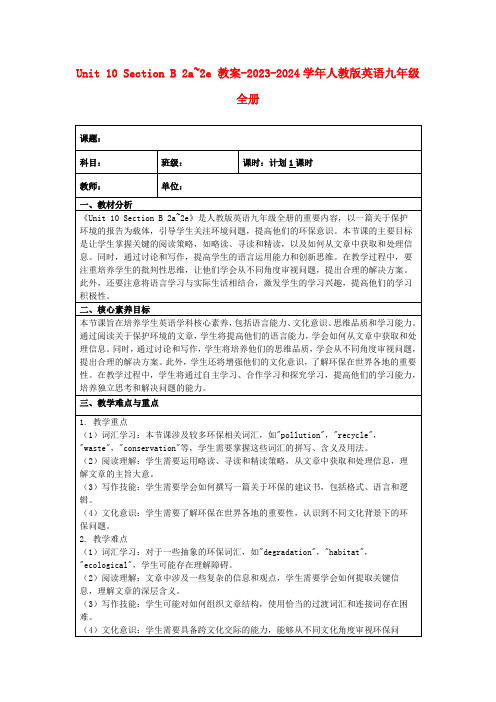
本节课旨在培养学生英语学科核心素养,包括语言能力、文化意识、思维品质和学习能力。通过阅读关于保护环境的文章,学生将提高他们的语言能力,学会如何从文章中获取和处理信息。同时,通过讨论和写作,学生将培养他们的思维品质,学会从不同角度审视问题,提出合理的解决方案。此外,学生还将增强他们的文化意识,了解环保在世界各地的重要性。在教学过程中,学生将通过自主学习、合作学习和探究学习,提高他们的学习能力,培养独立思考和解决问题的能力。
四、教学资源
软硬件资源:
- 教室内的多媒体设备,包括投影仪和计算机
- 学生使用的英语课本和练习册
- 白板和记号笔
- 录音机和听力材料
课程平台:
- 学校的学习管理系统(LMS),用于上传教学材料和作业
信息化资源:
- 环保相关的在线文章和视频,用于扩展学生的视野
- 英语学习网站,提供额外的练习和资源
教学手段:
(3)写作技能:学生需要学会如何撰写一篇关于环保的建议书,包括格式、语言和逻辑。
(4)文化意识:学生需要了解环保在世界各地的重要性,认识到不同文化背景下的环保问题。
2. 教学难点
(1)词汇学习:对于一些抽象的环保词汇,如"degradation","habitat","ecological",学生可能存在理解障碍。
3. 项目式学习:我引导学生进行项目式学习,让他们分组研究和设计一个环保项目。这种方式培养了学生的研究能力和创新思维,同时也提高了他们的团队合作能力和解决问题的能力。
(二)存在主要问题
1. 课堂时间管理:在课堂活动中,时间管理是一个主要问题。有时我会发现时间分配不够合理,导致某些环节过于冗长,而其他环节则显得匆忙。这可能会影响学生的学习效果和参与度。
人教版九年级英语全册优秀教学案例:Unit10sectionB
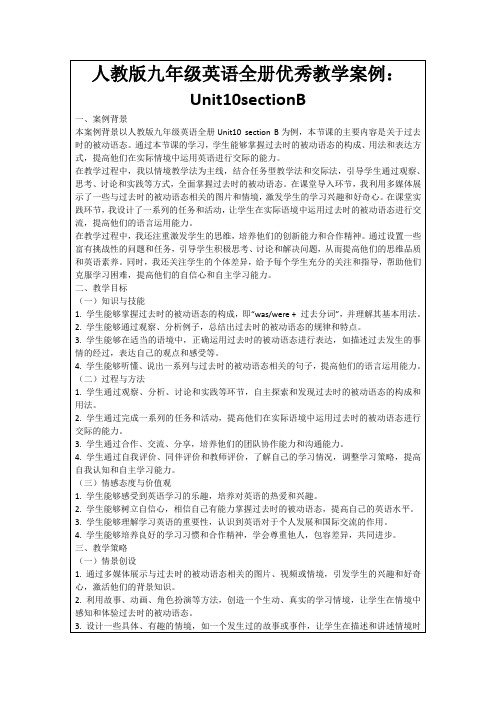
(四)总结归纳
1.教师引导学生回顾本节课所学习的内容,总结过去时的被动语态的构成、用法和表达方式。
2.学生可以通过制作思维导图、列出关键点等方式,整理和归纳所学知识,帮助记忆和复习。
3.教师可以进行课堂小测验或练习,检查学生对过去时的被动语态的掌握程度,及时发现和解决问题。
三、教学策略
(一)情景创设
1.通过多媒体展示与过去时的被动语态相关的图片、视频或情境,引发学生的兴趣和好奇心,激活他们的背景知识。
2.利用故事、动画、角色扮演等方法,创造一个生动、真实的学习情境,让学生在情境中感知和体验过去时的被动语态。
3.设计一些具体、有趣的情境,如一个发生过的故事或事件,让学生在描述和讲述情境时运用过去时的被动语态。
4.利用图片、图表、时间线等视觉辅助材料,帮助学生更好地理解和记忆过去时的被动语态的构成和用法。
(二)问题导向
1.设计一些富有挑战性和思考性的问题,引导学生积极思考、讨论和解决问题,激发他们的思维和探究欲望。
2.通过提问、讨论、解答等方式,引导学生发现和总结过去时的被动语态的规律和特点。
3.鼓励学生提出问题,培养他们的问题意识和解决问题的能力,引导学生自主探索和学习。
1.学生能够掌握过去时的被动语态的构成,即“was/were +过去分词”,并理解其基本用法。
2.学生能够通过观察、分析例子,总结出过去时的被动语态的规律和特点。
3.学生能够在适当的语境中,正确运用过去时的被动语态进行表达,如描述过去发生的事情的经过,表达自己的观点和感受等。
4.学生能够听懂、说出一系列与过去时的被动语态相关的句子,提高他们的语言运用能力。
Unit10SectionB2a-2e教案2023-2024学年人教版英语九年级全册
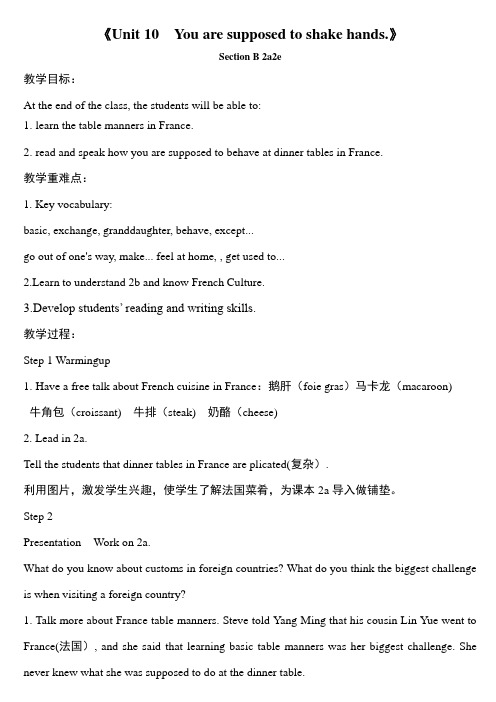
《Unit 10 You are supposed to shake hands.》Section B 2a2e教学目标:At the end of the class, the students will be able to:1.learn the table manners in France.2.read and speak how you are supposed to behave at dinner tables in France.教学重难点:1. Key vocabulary:basic, exchange, granddaughter, behave, except...go out of one's way, make... feel at home, , get used to...2.Learn to understand 2b and know French Culture.3.Develop students’ reading and writing skills.教学过程:Step 1 Warmingup1.Have a free talk about French cuisine in France:鹅肝(foie gras)马卡龙(macaroon)牛角包(croissant) 牛排(steak) 奶酪(cheese)2. Lead in 2a.Tell the students that dinner tables in France are plicated(复杂).利用图片,激发学生兴趣,使学生了解法国菜肴,为课本2a导入做铺垫。
Step 2Presentation Work on 2a.What do you know about customs in foreign countries? What do you think the biggest challenge is when visiting a foreign country?1. Talk more about France table manners. Steve told Yang Ming that his cousin Lin Yue went to France(法国), and she said that learning basic table manners was her biggest challenge. She never knew what she was supposed to do at the dinner table.2.Lead in 2b.Step 3Prereading Work on 2b.1..Read the letter once (3minutes) and find the topic sentence(中心句) for Paragraph One and Two. Then underline the topic sentence(划线).2. Call some students to read the answers.3.Read through the passage quickly and tell T/ F.(2 minutes)( )1. The letter is from France about table manners.( )2. Lin Yue is back now.( )3. She felt at home after she arrived in France.( )4.The letter is from Lin Yue to Luara.4. Check answers in class.阅读信件,回答问题,对文章作初步了解。
2021年九年级英语全册-Unit-10--Section-B-2a-2e教案-(新版)人教新目标版
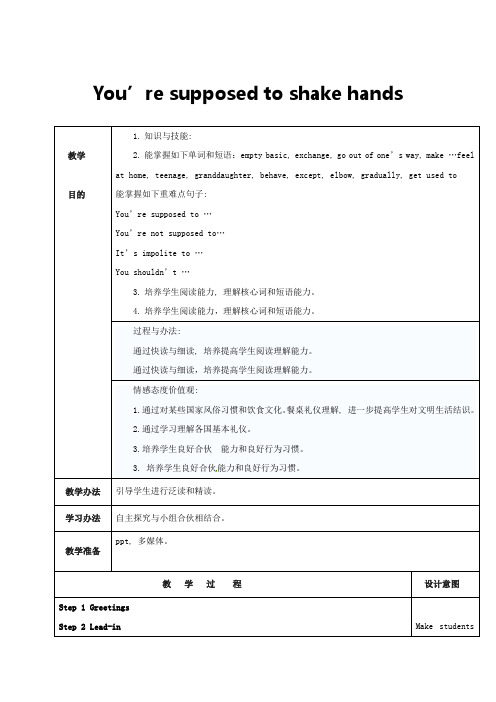
4.Another example is that you’renot supposed to eat anything with your hand except bread,not even fruit.
except作介词, 意为“除……之外”, 和but意义相似, 但语调上要比but更加强烈。
教学准备
ppt, 多媒体。
教 学 过 程
设计意图
Step 1 Greetings
Step 2Lead-in
播放一种法国人就餐图片, 让学生观测法国人就餐习惯, 然后教师问: 她们可以用手拿水果吃吗?设立悬念, 引导学生阅读。
Step 3Fast Reading
1.Let students read the passage fast and check the sentences (T or F)
1) Lin Yue enjoys her change life in France.( )
2) Lin Yue was never nervous before she arrived in France.( )
3) People are supposed to put their bread on their plates.( )
2.Students read the passage again and replace the underlined words with the phrases in the box.
1)Making mistakes in French usedto make Lin Yue nervous.
go out of one’s way 特地;格外努力
Unit10SectionB(2a-2e)大单元教学课时设计人教版英语九年级全册
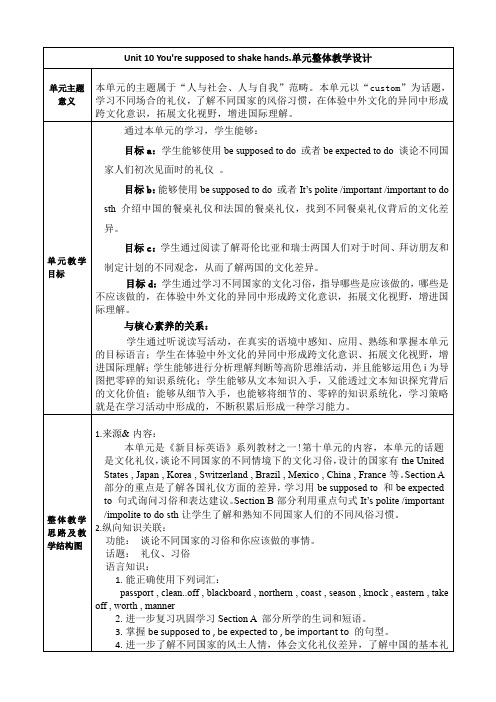
学的活动4
细读文章,检查预测
ቤተ መጻሕፍቲ ባይዱ回答问题
学的活动3
1.Ssobserve the images and understand the situation.
2. Ssplete thequestionsand answers using past future tense.
通过本单元的学习,学生能够:
目标a:学生能够使用be supposed to do或者be expected to do谈论不同国家人们初次见面时的礼仪。
目标b:能够使用be supposed to do或者It’s polite /important /important to do sth介绍中国的餐桌礼仪和法国的餐桌礼仪,找到不同餐桌礼仪背后的文化差异。
Section B 1a1d
听说课
第三课时
通过使用听力技巧听懂对话;并能拓展Section A的语言表达。
通过问题启发式评价引导学生,评价学生对语篇主题的理解;通过个人思考和合作交流,评价学生主动参与到学习中的能力。
Section B 2a2e
阅读课
第四课时
学生能学会重点单词、短语及目标语言;能读懂文章,掌握重点句型并运用;能理解关键词和短语;学生能使用目标语言谈论不同国家的风俗。
整体教学思路及教学结构图
1.来源&内容:
本单元是《新目标英语》系列教材之一!第十单元的内容,本单元的话题是文化礼仪,谈论不同国家的不同情境下的文化习俗,设计的国家有the United States , Japan , Korea , Switzerland , Brazil , Mexico , China , France等。Section A部分的重点是了解各国礼仪方面的差异,学习用be supposed to和be expected to句式询问习俗和表达建议。Section B部分利用重点句式It’s polite /important /impolite to do sth让学生了解和熟知不同国家人们的不同风俗习惯。
人教版英语九年级全册Unit10SectionB(2a2e)课时说课稿

在新知讲授阶段,我将逐步呈现知识点,引导学生深入理解:
1.教学重点:
(1)掌握关于环境保护的词汇和短语;
(2)学会使用现在进行时和一般将来时描述环境问题及解决方案;
(3)培养学生的阅读理解能力和思辨能力。
2.教学难点:
(1)正确运用现在进行时和一般将来时描述环境问题及解决方案;
(2)阅读理解文章,提取关键信息并进行整合;
(3)培养学生关注环保问题,提高环保意识。
4.激励评价:及时给予学生积极的评价和反馈,增强他们的自信心,提高学习积极性;
5.联系实际:引导学生关注生活中的环保问题,将所学知识与社会实践相结合,使学生认识到学习英语的实际意义。
三、教学方法与手段
(一)教学策略
我将采用以下主要教学方法:任务型教学法、合作学习法和情境教学法。
1.任务型教学法:通过设置具有挑战性的任务,引导学生积极参与,使学生在完成任务的过程中运用所学知识,提高语言实际运用能力。这一方法的理论依据是交际法,强调在实际语境中学习和使用语言。
(二)媒体资源
我将使用以下教具、多媒体资源和技术工具来辅助教学:
1.教具:环保海报、词汇卡片、时间轴等,用于直观展示和强化知识点。
2.多媒体资源:播放关于环保的图片、视频和动画,帮助学生更好地理解课文内容,激发学习兴趣。
3.技术工具:利用PPT、互动白板等,展示教学内容,实现师生互动;利用在线平台,发布任务和作业,方便学生提交和反馈。
(二)学习障碍
在学习本节课之前,学生已经掌握了关于环保的一些基本知识和词汇,具备了一定的语言基础。然而,可能存在以下学习障碍:
1.对本节课的核心词汇和短语掌握不够熟练,影响阅读理解和表达;
2.对现在进行时和一般将来时的运用不够熟练,容易混淆;
人教版九年级第十单元Section B 2a—2e 教案
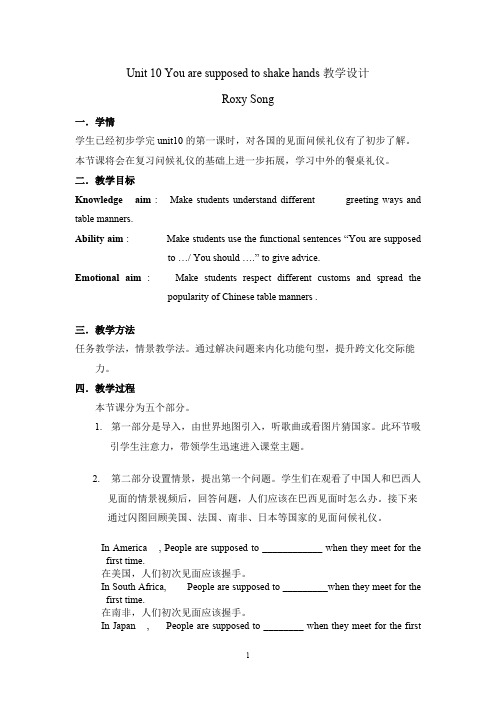
Unit 10 You are supposed to shake hands教学设计Roxy Song一.学情学生已经初步学完unit10的第一课时,对各国的见面问候礼仪有了初步了解。
本节课将会在复习问候礼仪的基础上进一步拓展,学习中外的餐桌礼仪。
二.教学目标Knowledge aim : Make students understand different greeting ways and table manners.Ability aim : Make students use the functional sentences “You are supposedto …/ You should ….” to give advice.Emotional aim : Make students respect different customs and spread thepopularity of Chinese table manners .三.教学方法任务教学法,情景教学法。
通过解决问题来内化功能句型,提升跨文化交际能力。
四.教学过程本节课分为五个部分。
1. 第一部分是导入,由世界地图引入,听歌曲或看图片猜国家。
此环节吸引学生注意力,带领学生迅速进入课堂主题。
2. 第二部分设置情景,提出第一个问题。
学生们在观看了中国人和巴西人见面的情景视频后,回答问题,人们应该在巴西见面时怎么办。
接下来通过闪图回顾美国、法国、南非、日本等国家的见面问候礼仪。
In America , People are supposed to ____________ when they meet for the first time.在美国,人们初次见面应该握手。
In South Africa, People are supposed to _________when they meet for the first time.在南非,人们初次见面应该握手。
Unit10 SectionB(2a-2e)教案设计
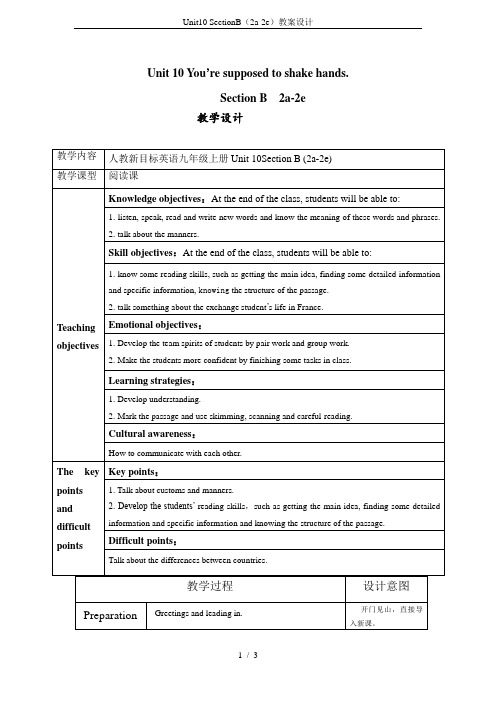
Homework
write a short passage.介绍餐桌礼仪。
以读促写,培养学生的写作能力。
Blackboard design :
Unit10 Section B (2a-2e)
You are supposed to…
You are not supposed to…
2.学生自主活动:根据书上的图片和标题预测
林悦的挑战。
通过图片让学生复习学过的句型,为本节课内容铺垫。
通过预测激发和调动学生阅读文章的兴趣。
While-reading
1.请学生把课文标注段落。
2.Task One:skimming略读文章,找出文章的中心句。
3.Task Two:scanning跳读文章,找同义短语。
Cultural awareness:
How to communicate with each other.
The key points and difficult points
Key points:
1. Talk about customs and manners.
2. Develop the students’ reading skills,such as getting the main idea, finding some detailed information and specific informationandknowing the structure of the passage.
Difficult points:
Talk about the differences between countries.
教学过程
设计意图
Preparation
Unit10第5课时(SectionB2a2e)(教学设计)九年级英语全一册(人教新目标GoForI
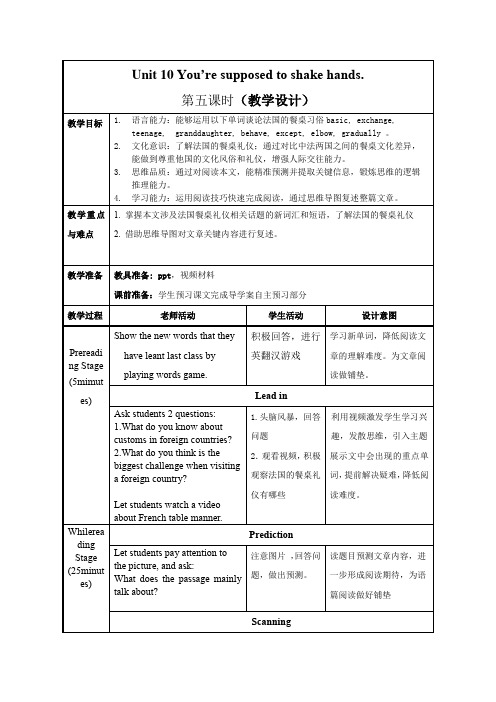
巩固所学知识
Homework
Present homework:
1.Retell the passage again after school. (B层)
2.Write a short passage aboutthe differences and similarities betweenChinesetablemannersand French table manners.(A层)
Carefulreadingpar
Letstudents cir源自le thelinkingwordsin this passage, and let them finish the blank.
Make
细读第一段,完成2a.
深度阅读理解,了解法国留学生活,找出关键词:fortable
Carefulreadingpar
Unit10You’re supposed to shake hands.
第五课时(教学设计)
教学目标
1.语言能力:能够运用以下单词谈论法国的餐桌习俗basic, exchange, teenage, granddaughter, behave, except, elbow, gradually 。
积极回答,进行英翻汉游戏
学习新单词,降低阅读文章的理解难度。为文章阅读做铺垫。
Lead in
Ask students 2 questions:
1.What do you know about customs in foreign countries?
2.What do you think is the biggest challenge when visiting a foreign country?
人教版英语九年级全册Unit10 SectionB(2a-2e)优质课教案
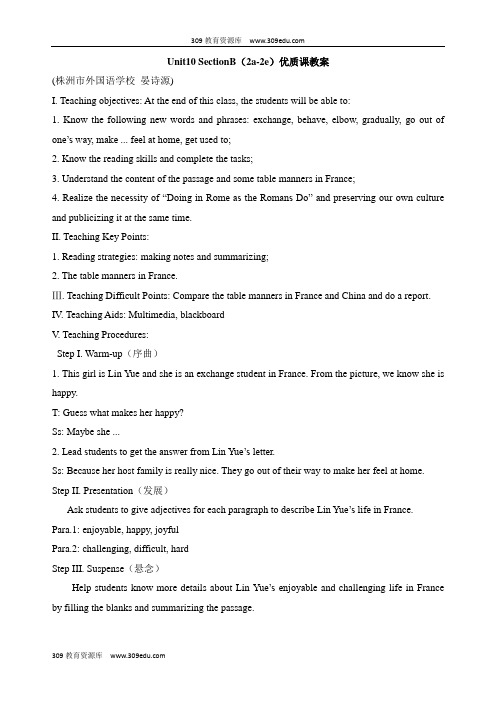
Unit10 SectionB(2a-2e)优质课教案(株洲市外国语学校晏诗源)I. Teaching objectives: At the end of this class, the students will be able to:1. Know the following new words and phrases: exchange, behave, elbow, gradually, go out of one’s way, make ... feel at home, ge t used to;2. Know the reading skills and complete the tasks;3. Understand the content of the passage and some table manners in France;4. Realize the necessity of “Doing in Rome as the Romans Do” and preserving ou r own culture and publicizing it at the same time.II. Teaching Key Points:1. Reading strategies: making notes and summarizing;2. The table manners in France.Ⅲ. Teaching Difficult Points: Compare the table manners in France and China and do a report. IV. Teaching Aids: Multimedia, blackboardV. Teaching Procedures:Step I. Warm-up(序曲)1. This girl is Lin Yue and she is an exchange student in France. From the picture, we know she is happy.T: Guess what makes her happy?Ss: Maybe she ...2. Lead students to get the answer from Lin Yue’s letter.Ss: Because her host family is really nice. They go out of their way to make her feel at home. Step II. Presentation(发展)Ask students to give adjectives for each paragraph to describe Lin Yue’s life in France. Para.1: enjoyable, happy, joyfulPara.2: challenging, difficult, hardStep III. Suspense(悬念)Help students know more details about Lin Y ue’s enjoyab le and challenging life in France by filling the blanks and summarizing the passage.Step IV. Climate(高潮)1. Review the table manners in China by some pictures.2. Compare the table manners in France and China. How are they the same or different? Make a list and do a report.(Group work) Report like this: Hello, everyone. I’m the reporter. In our group, we have summarized the similar and different table manners between China and France. ... ______________________________________________________________________________ ______________________________________________________________________________ ______________________________________________________________________________ ______________________________________________________________________________。
Unit10SectionB(2a-2e)教案九年级英语全一册精品课堂(人教版)
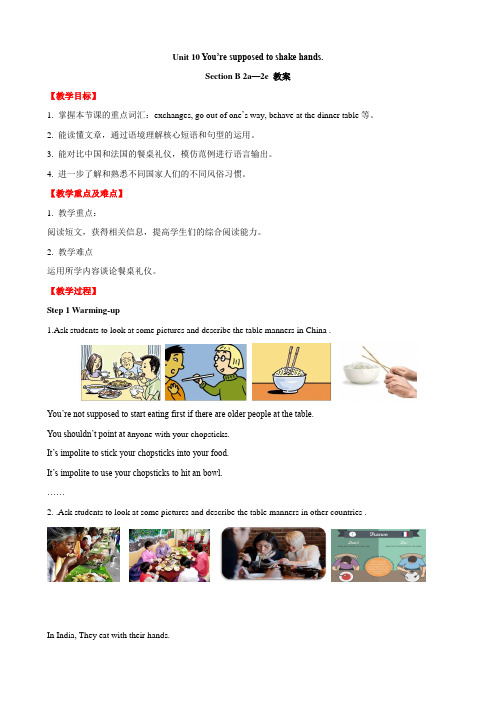
Unit 10 You’re supposed to shake hands.Section B 2a—2e 教案【教学目标】1. 掌握本节课的重点词汇:exchanges, go out of one’s way, behave at the dinner table等。
2. 能读懂文章,通过语境理解核心短语和句型的运用。
3. 能对比中国和法国的餐桌礼仪,模仿范例进行语言输出。
4. 进一步了解和熟悉不同国家人们的不同风俗习惯。
【教学重点及难点】1. 教学重点:阅读短文,获得相关信息,提高学生们的综合阅读能力。
2. 教学难点运用所学内容谈论餐桌礼仪。
【教学过程】Step 1 Warming-up1.Ask students to look at some pictures and describe the table manners in China .You’re not supposed to start eating first if there are older people at the table.You shouldn’t point at a nyone with your chopsticks.It’s impolite to stick your chopsticks into your food.It’s impolite to use your chopsticks to hit an bowl.……2. .Ask students to look at some pictures and describe the table manners in other countries .In India, They eat with their hands.In Japan, you are supposed to make noise while eating noodles.In France, you are supposed to put your bread on the table.In France, keep both hands above the table.……【设计意图】看图描述并复习学过的餐桌礼仪。
- 1、下载文档前请自行甄别文档内容的完整性,平台不提供额外的编辑、内容补充、找答案等附加服务。
- 2、"仅部分预览"的文档,不可在线预览部分如存在完整性等问题,可反馈申请退款(可完整预览的文档不适用该条件!)。
- 3、如文档侵犯您的权益,请联系客服反馈,我们会尽快为您处理(人工客服工作时间:9:00-18:30)。
Go for it Unit9.SectionB---Reading Sad but beautiful
Teaching design
Ⅰ.Teachings Aims:
Language aim: Ss can understand the passage.
Ability aim: By practicing Ss can develop their reading, speaking listening and writing abilities.
Moral aim: Ss can learn the spirits of Abing and get to learn to appreciate(欣赏) the Chinese folk music.
Ⅱ.Teaching methods:
Task-based Language Teaching , Communicative Teaching , Translation Method, Audio-Lingual Method
Ⅲ. Teachings Steps:
Warming----up: Good morning, boys and girls! I think everyone likes music. Now let’s enjoy a piece of music. After hearing it ,we are going to talk about it.
Activity1:Pre- reading
experiences(回忆起了他们的忧伤或痛苦的经历所带来的深深的创伤)
Activity2:Fast reading
Read the passage quickly and match each paragraph with the main idea. Pagragh1. Abing lived a hard life.
Pagragh2. Abing’s musical skills made him very popular. Pagragh3. I was moved by a piece of music.
(Tip: Sometimes the topic sentence can be found at the beginning or the end of the paragraph. )
Activity3:Detail reading
Read and answer
1). Which musician does the passage talk about?
2). What is the name of his most famous piece of music?
3). How did the writer feel about the piece of music?
4). What was he known for?
5).Do you like A’bing’s music? Why or Why not?
Activity4: Listening and reading
(Tip: Pay attention to the pronunciation while you are listening to the passage. )
Reading Competition:Group1-------Group12
Activity5:Post---reading
Free talk: What are the sprits of A’bing and what can we learn from A’bing ?。
